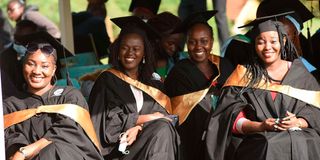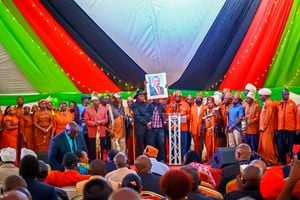Make university accessible, experts told

Graduands follow proceedings during the Moi University 43rd Graduation Ceremony in Kesses, Uasin Gishu County on June 23, 2022.
What you need to know:
- Although the overall unemployment stands at 12.7 per cent, the youth (15-34 years), who form 35 per cent of the population, have the highest unemployment rate of 67 per cent.
- More than 500,000 students are enrolled in the universities. The pioneer Competence Based Curriculum (CBC) class will join university in 2029.
- CBC rollout is now in Grade Six, with learners due for assessment next month to transit to junior secondary in 2023.
A forum on education reforms was challenged to find solutions to improve access to higher learning in light of concerns that millions of young people join the labour market without proper skills.
The team, appointed by President William Ruto, was told that the strategies should also address the inequality that disadvantages children from poor backgrounds from accessing tertiary education.
The meeting was told Kenya is among the countries with the highest mismatch, with highly educated people working the same jobs as those who are less skilled.
Mr Pedro Cerdan-Infantes, a senior economist with Education Global Practice at the World Bank, said every year, one million youth join the labour market although few have the necessary tertiary education.
“The question is: How many of them do we expect to have some tertiary education? Right now; very few and we hope that could be increased,” Mr Pedro said in a presentation on trends on education financing globally. He lamented the mismatch in job placement.
Unemployment rate
According to the Federation of Kenya Employers (FKE), although the overall unemployment stands at 12.7 per cent, the youth (15-34 years), who form 35 per cent of the population, have the highest unemployment rate of 67 per cent.
Mr Cerdan-Infantes, however, acknowledged the rapid growth in tertiary institutions in the country.
A report presented at the meeting of the Presidential Working Party on Education Reforms in Karen showed rapid expansion in higher education over the past 20 years, with the country now having 78 universities.
More than 500,000 students are enrolled in the universities. The pioneer Competency-Based Curriculum (CBC) class will join university in 2029.
CBC rollout is now in Grade Six, with learners due for assessment next month to transit to junior secondary in 2023.
Experts expected to recommend changes to improve the sector, including the new curriculum, are being challenged to explore how prepared universities are for this.
Yesterday, Mr Cerdan-Infantes stressed the need to expand equity and invest in higher education.
“We are realising that tertiary education is instrumental and equity has become the biggest issue. It is [wrong] that only the rich can access higher education,” he said.
Ms Ruth Charo, a specialist with Education Global Practice of the World Bank, suggested more bursaries and higher education loans to students from poor backgrounds to bridge the gap.
“Equity is a crawling issue in Kenya and we have to deal with it. The middle and upper class are the ones who have access to university education (more) than a child coming from the two bottom quintile households.”
“We want you to look at the targeting mechanisms for loans and bursaries. Is it objective? Why is the data showing a child from a middle-income family is 49 times more likely to access university than a child coming from a low-income household?”
The 49-member team reviewing the CBC started induction on Wednesday. It ends today and the team will criss-cross the country to collect views from the public. According to the Kenya Gazette, the task force will, among other things, evaluate the CBC.
The team is mandated to review the implementation of key tenets guiding the competency-based approach, including but not limited to value-based education, community service learning, parental empowerment and engagement.




